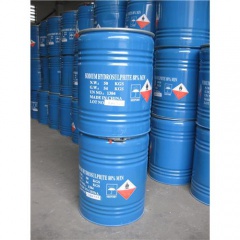Sodium hydrosulphite
| Infobox on Sodium hydrosulphite | |
|---|---|
| Example of Sodium hydrosulphite |  |
| Facts | |
| Origin | - |
| Stowage factor (in m3/t) | - |
| Humidity / moisture | - |
| Ventilation | - |
| Risk factors | See text |
Sodium hydrosulphite
Contents
Description
Sodium dithionite (also known as sodium hydrosulfite) is a white crystalline powder with a weak sulfurous odour. It is a sodium salt of dithionous acid. Although it is stable under most conditions, it will decompose in hot water and in acid solutions.
Sodium dithionite, Na2S2O4 , is the only industrially important salt of dithionous acid (H2S2O4), which has not been isolated. The importance of sodium dithionite lies in its powerfull reducing capacity, which allows, for example, vat dyes to be reduced at room temperature.
Derivation:
- Zinc is dissolved in a solution of sodium bisulfite, the zinc-sodium sulphite precipitated by milk of lime, leaving the hydrosulfite in solution.
- Reaction of sodium formate with sodium hydroxide and sulphur dioxide.
Application
- Printing and Dyeing in the Textile and Leather industries.
- Bleaching of Minerals and Aluminium Oxides.
- Effluent Treatment e.g. in the Galvanization Industry.
- Paper and Pulp industries for the bleaching of wood pulp and recycled paper.
Shipment / Storage / Risk factors
Usually shipped in drums. Rapidly deteriorates on exposure to air. If drums become opened up in any way immediate measures should be taken to dispose of the contents. Subject to heating. Fire risk in contact with water.
Consult the IMDG Code (International Maritime Dangerous Goods Code) and applicable MSDS sheet for safety handling advice.











